The Palace of the Porphyrogenitus (Greek: τὰ βασίλεια τοῦ Πορφυρογεννήτου), known in Turkish as the Tekfur Sarayı ("Palace of the Sovereign"), is a late 13th-century Byzantine palace in the north-western part of the old city of Constantinople (present-day Istanbul, Turkey). An annex of the greater palace complex of Blachernae,
it is the only Byzantine palace to survive in the city, and one of the
few relatively intact examples of late Byzantine secular architecture in
the world.
The Palace was constructed during the late 13th or early 14th centuries as part of the Blachernae palace complex, where the Theodosian Walls join with the later walls of the suburb of Blachernae. Although the palace appears at first glance to be named after the 10th-century emperor Constantine VII Porphyrogenitus, it was built long after his time, and is in fact named after Constantine Palaiologos, a son of the Emperor Michael VIII Palaiologos. "Porphyrogenitus",
meaning literally "born to the purple", indicated a child born to a
reigning emperor. The palace served as an imperial residence during the
final years of the Byzantine Empire.
The palace suffered extensive damage due to its proximity to the outer walls during the Ottoman conquest
of Constantinople in 1453. Afterwards it was used for a wide variety of
purposes. During the 16th and 17th century, it housed part of the
Sultan's menagerie. The animals were moved elsewhere by the end of the 17th century, and the building was used as a brothel. From 1719, the Tekfur Sarayı pottery workshop was established, and began to produce ceramic tiles in a style similar to that of İznik tiles, but influenced by European designs and colors. The workshop had five kilns and also produced vessels and dishes.
It lasted for around a century before going out of business, and by the
first half of the 19th century, the building became a poorhouse for
Istanbul Jews. In the early 20th century, it was briefly used as a bottle factory, before being abandoned. As a result, only the elaborate brick and stone outer façade survives today, the only major surviving example of secular Byzantine architecture apart from the halls of the Palazzo dei Normanni. As of July 2010, the palace has been undergoing extensive restoration, and remains closed to the public.
Tekfur Sarayı, İstanbul'da bulunan Blakernai saray kompleksinden günümüze kalan tek saray. Yedi tepesi ayrı güzel İstanbul Şehrinin, Fatih İlçesi sınırları
içerisinde kalan Edirnekapı Semti’nde; kara surlarına bitişik olarak
inşa edilmiş, konum olarak Edirnekapı ve Eğrikapı arasında kalan kalın
duvarlı saray “Tekfur Sarayı” olarak isimlendirilir.
Tekfur Sarayı’nın ne zaman ve kimler tarafından inşa edildiği konusunda
net bir bilgi bulunmamaktadır. Bazı tarihi kaynaklarda, İsa’nın
doğumundan sonra onuncu asırda Bizans İmparatoru Porfirogenetos emri ile
yaptırıldığı ve arka kısmında bulunan büyük sarayın ek binası olduğu
savunulmaktadır. Bu bilgiyi reddeden diğer tarihi kaynakların görüşü ise
milattan sonra on üçüncü ve on dördüncü asırlarda “Blakhernai Sarayı” olarak bilinen sarayda yaşayan hizmetkarların ikamet etmesi için yapıldığı yönündedir.
Fatih Sultan Mehmet tarafından İstanbul’un fethedilmesinden sonra
“Tekfur Sarayı”, on yedinci yüzyılın sonlarına kadar metruk şekilde
kalmıştır. On yedinci asrın sonlarında ise Tekfur Sarayı’na hayvanat
bahçesi kurulmuştur. İstanbul şehrine gezgin olarak gelen John Sanderson’un rivayetine göre ise kendinden kırk yıl evvel gelen Ogier Ghiselin de Busbecq,
buradaki hayvanat bahçesinde bulunan zürafayı görmek istemiş fakat
zürafa birkaç gün önce öldüğünden dolayı dünyada hiçbir ülkede
göremediği bu canlıyı görmek ve merakını gidermek için zürafanın
mezarını kazdırmak sureti ile merakını nihayetlendirmiştir.
On sekizinci yüzyıl başlarında seramik atölyesi olarak kullanılan
“Tekfur Sarayı”, on dokuzuncu yüzyıl ortalarından itibaren cam ve cam
ürünleri imalathanesine dönüştürülmüştür. Dünyaca ünlü “kaşıkçı elması”
ise “Tekfur Sarayı”nın çöplüğünde bulunmuştur.
Günümüzde ise yeni tarihi olaylara şahitlik etmek amacı ile Tekfur Sarayı’ndaki arkeolojik kazılar sürmeye devam etmektedir.
Origin Wikipedia....































Post a Comment